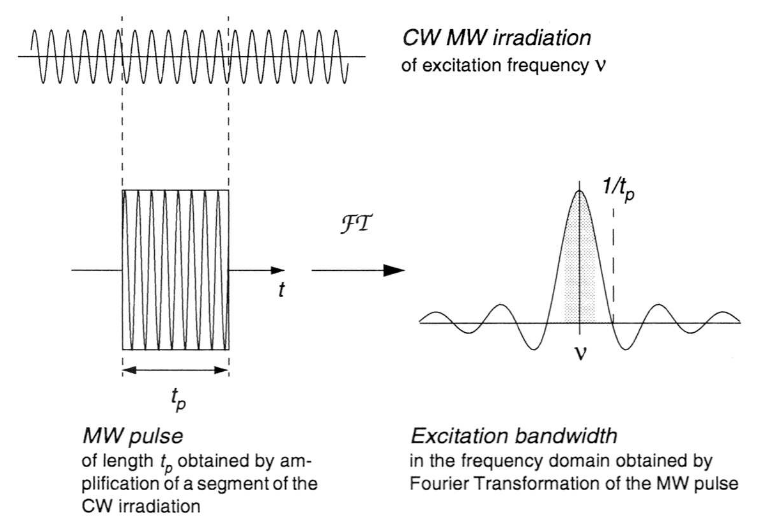CW and Pulse EPR
EPR spectra can be recorded in different frequency regions, the most important being S-band (2-4 GHz), X-band (8-10 GHz), Q-band (~35 GHz) and W-band (~90 GHz). The magnetic field strengths necessary to obtain the appropriate Zeeman splitting can be deduced from the resonance condition (Eq. (3)). Most of the applications in this thesis have been done at X-band frequencies, which corresponds to a magnetic field of approximately 320 mT at g = 2.
CW EPR spectra are recorded by putting a sample into a MW irradiation field of constant frequency ν and sweeping the external magnetic field B0 until the resonance condition is fulfilled. In the experimental set-up, the MW field is build up in a resonator (typically a rectangular cavity), into which the sample tube is introduced. The MW irradiation is provided by a klystron and transferred to the cavity through waveguides. The resonator is critically coupled which means that the incident power is completely absorbed by the resonator. Additional absorption by the sample during resonance leads to a detuning of the resonator and reflection of MW power. The recording of this reflected MW power as a function of the magnetic field yields the CW EPR spectrum. Amplitude modulation of the magnetic field with a frequency of typically 100 kHz increases the signal-to-noise (S/N) ratio considerably and is responsible for the derivative shape of the spectra. The excitation bandwidth of the MW irradiation is very small (approximately 2 MHz) and the MW power is at maximum 200 mW.
In pulse EPR the spectrum is recorded by exciting a large frequency range simultaneously with a single high-power MW pulse of given frequency ν at a constant magnetic field B0. The relation between pulse length and excitation bandwidth is shown in Fig. 8. The excitation profile of the pulse is obtained in the limits of the linear response theory by Fourier Transformation of the pulse shape4. This corresponds to a sinc function (sin(x)/x) for a rectangular pulse where the first zero crossings of the sinc function away from the central frequency are given by 1/tp. Uniform excitation is considered to be given approximately in the shaded area delimited by ν ± 1/2 tp. An excitation bandwidth of 100 MHz is thus obtained for a 10 ns pulse, which corresponds to 3 mT at g = 2. Reduction of the pulse length leads to broader excitation range. Due to technical limitations it is, however, in most cases impossible to excite the whole spectrum by a single EPR pulse, which is a severe limitation as compared to NMR. The length of the pulse thus determines the selectivity of the excitation. The bandwidth of the resonator containing the sample is much larger than the one of the CW EPR cavity to allow for a rapid dissipation of the high power brought into the resonator by the MW pulse. During and immediately after the MW pulse the sensitive detector must be protected from the high MW power in the resonator, and signal recording is not possible. This so-called deadtime of the spectrometer depends on the bandwidth of the resonator and is at X band in the range of 100 ns. By increasing the bandwidth of the resonator the dead time can be reduced. But the large bandwidth of the pulse EPR resonator is responsible for the lower sensitivity as compared to CW EPR.

Fig. 8: The length of the MW pulse, obtained by amplifying a segment of the CW irradiation, determines the excitation bandwidth of the pulse. Homogeneous excitation is expected in the shaded area of width 1/tp.
Most EPR applications still make use of continuous wave methods as the recording and interpretation of pulse EPR spectra requires sophisticated technical equipment and a more advanced theoretical background. A significant advantage of CW EPR with respect to the pulse methods is the higher sensitivity. A further limitation of pulse EPR are also the low measuring temperatures imposed by the short relaxation of the transverse magnetization involved in pulse experiments, especially for transition metal ions. CW EPR spectra on the other hand can be recorded at room temperature for a large number of spin systems, including radicals and transition metal ions. The additional information about weakly coupled nuclei and relaxation properties of the spin system that can be obtained by manipulating the spins with sequences of MW pulses explains on the other hand the efforts put into the development of new pulse methods. The enhancement of forbidden transitions or the establishing of correlations via 2D spectroscopy are examples for such manipulations. Nevertheless CW and pulse EPR are complementary and only the application of both gives a reliable picture of the spin system.
4 Under the excitation of MW pulses the electron spin systems shows a strongly non-linear behavior. The assumption of a linear response is only valid for weak excitation by soft pulses with nominal flip angles < 90°.